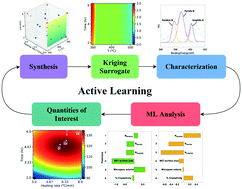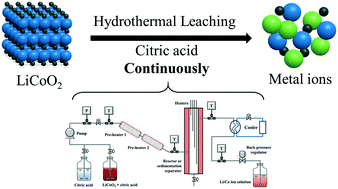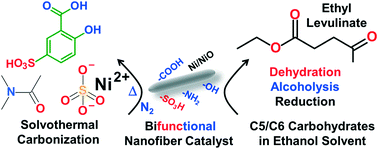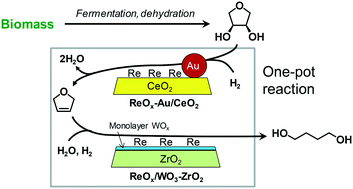Themed collection Green Chemistry and Reaction Engineering

Introduction to green chemistry and reaction engineering
George Huber, Alexei Lapkin and Yan Ning introduce the Reaction Chemistry & Engineering themed issue on green chemistry and reaction engineering.

React. Chem. Eng., 2020,5, 2131-2133
https://doi.org/10.1039/D0RE90041A
Production of jet-fuel-range molecules from biomass-derived mixed acids
Mixed acids from open culture fermentation can be catalytically upgraded to long-chain species suitable for use in jet fuel applications.

React. Chem. Eng., 2021,6, 845-857
https://doi.org/10.1039/D0RE00401D
Solvent-free manufacture of methacrylate polymers from biomass pyrolysis products
Biomass pyrolysis liquid is functionalised into a potential replacement for petrochemical derived methacrylates used in resins, adhesives and binders.

React. Chem. Eng., 2021,6, 335-344
https://doi.org/10.1039/D0RE00419G
Active learning-driven quantitative synthesis–structure–property relations for improving performance and revealing active sites of nitrogen-doped carbon for the hydrogen evolution reaction
A data-driven quantitative synthesis–structure–property relation methodology to elucidate correlations between catalyst synthesis conditions, structural properties and observed performance, providing a systematic way to optimize practical catalysts.

React. Chem. Eng., 2020,5, 2134-2147
https://doi.org/10.1039/D0RE00243G
Continuous hydrothermal leaching of LiCoO2 cathode materials by using citric acid
Continuous hydrothermal leaching of LiCoO2 cathode materials with citric acid was firstly achieved using a customized flow system.

React. Chem. Eng., 2020,5, 2148-2154
https://doi.org/10.1039/D0RE00286K
Direct comparison of safer or sustainable alternative dipolar aprotic solvents for use in carbon–carbon bond formation
Direct comparison of safer dipolar aprotic solvents for use in carbon–carbon bond formation is of vital importance for industrial applications. Cyrene exhibited high initial reaction rates, yields and solvent recovery in the Baylis–Hillman reaction.

React. Chem. Eng., 2020,5, 1798-1804
https://doi.org/10.1039/D0RE00174K
Bifunctional carbon Ni/NiO nanofiber catalyst based on 5-sulfosalicylic acid for conversion of C5/C6 carbohydrates into ethyl levulinate
A method was developed for preparing bifunctional carbon Ni/NiO nanofiber catalysts that promote efficient one-pot conversion of C5/C6 carbohydrates into levulinate esters in alcohol solvents.

React. Chem. Eng., 2020,5, 1759-1767
https://doi.org/10.1039/D0RE00153H
Tetrahydrofuran-based two-step solvent liquefaction process for production of lignocellulosic sugars
THF-based solvent liquefaction demonstrates a new economic and sustainable approach for fractionating, saccharifying biomass with simple and efficient solvent recovery.

React. Chem. Eng., 2020,5, 1694-1707
https://doi.org/10.1039/D0RE00192A
Hydrogenolysis of alginic acid over mono and bimetallic ruthenium/nickel supported on activated carbon catalysts with basic promoters
Hydrogenolysis of alginic acid, derived from macroalgae, was performed over Ru–Ni supported on activated carbon catalyst using NaOH as basic promoter to produce glycols.

React. Chem. Eng., 2020,5, 1783-1790
https://doi.org/10.1039/D0RE00224K
Tungsten–zirconia-supported rhenium catalyst combined with a deoxydehydration catalyst for the one-pot synthesis of 1,4-butanediol from 1,4-anhydroerythritol
Biomass-derived 1,4-anhydroerythritol is reduced to 1,4-butanediol over a reusable mixture of heterogeneous catalysts, ReOx–Au/CeO2 and ReOx/WO3–ZrO2.

React. Chem. Eng., 2020,5, 1237-1250
https://doi.org/10.1039/D0RE00085J
About this collection
From Reaction Chemistry & Engineering
Guest Editors: Professor George Huber (University of Wisconsin-Madison, US), Professor Alexei Lapkin (University of Cambridge, UK) and Professor Ning Yan (National University of Singapore, SG).
The development of new routes for the introduction of molecules into industrial supply chains is an important research area. The use of waste products and renewable resources in particular is key to the concept of the circular economy. Although there is an increasing number of papers on new chemical transformations to support the transition to circularity, there are few studies on engineering the new process concepts.
Reaction engineering of these chemical transformations is an important engineering theme necessary if these new chemical transformations are to become industrially viable.